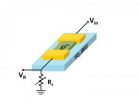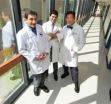(Press-News.org) It is widely believed that DHA (docosahexaenoic acid) is good for your brain, but how it is absorbed by the brain has been unknown. That is - until now. Researchers from Duke-NUS Graduate Medical School Singapore (Duke-NUS) have conducted a new study identifying that the transporter protein Mfsd2a carries DHA to the brain. Their findings have widespread implications for how DHA functions in human nutrition.
People know that DHA is an essential dietary nutrient that they can get from seafood and marine oils. Baby formula companies are especially attuned to the benefits of DHA, with nary a baby formula marketed without it.
DHA is an omega-3 fatty acid most abundantly found in the brain that is thought to be crucial to its function. However, the brain does not produce DHA. Instead, DHA uptake in the brain happens in two ways. The developing brain receives DHA during fetal development, from a mother to her baby. The adult brain gets it through food or DHA produced by the liver.
Though DHA is postulated to benefit the brain, the mechanics of how the brain absorbs the fatty acid has remained elusive. Senior author of the research, Associate Professor David L. Silver of Duke-NUS explained the importance of unlocking this mystery.
"If we could show the link by determining how DHA gets into the brain, then we could use this information to more effectively target its absorption and formulate an improved nutritional agent."
In the study, led by post-doctoral fellow Long N. Nguyen of Duke-NUS, researchers found that mice without the Mfsd2a transporter had brains a third smaller than those with the transporter, and exhibited memory and learning deficits and high levels of anxiety. The team recognized that the learning, memory and behavioral function of these mice were reminiscent of omega-3 fatty acid deficiency in mice starved of DHA in their diet.
Then, using biochemical approaches, the team discovered that mice without Mfsd2a were deficient in DHA and made the surprising discovery that Mfds2a transports DHA in the chemical form of lysophosphatidlycholine (LPC). LPCs are phospholipids mainly produced by the liver that circulate in human blood at high levels. This is an especially significant finding as LPCs have been considered toxic to cells and their role in the body remains poorly understood. Based on this surprising new information, Dr Silver's team showed that Mfsd2a is the major pathway for the uptake of DHA carried in the chemical form of LPCs by the growing fetal brain and by adult brain.
The findings, published online in Nature the week of May 12, 2014 marks the first time a genetic model for brain DHA deficiency and its functions in the brain has been made available.
"Our findings can help guide the development of technologies to more effectively incorporate DHA into food and exploit this pathway to maximize the potential for improved nutritionals to improve brain growth and function. This is especially important for pre-term babies who would not have received sufficient DHA during fetal development," said Dr Silver, who is from the Cardiovascular and Metabolic Disorders Program at Duke-NUS.
INFORMATION:
In addition to Dr. Silver and Dr. Nguyen, study authors include Dr. Dongliang Ma, Dr. Peiyan Wong, Assistant Professor Xiaodong Zhang and Assistant Professor Eyleen Goh from Duke-NUS and Dr. Guanghou Shui, Dr. Amaury Cazenave Gassiot and Associate Professor Markus Wenk from the Yong Loo Lin School of Medicine, National University of Singapore. Part of the research was carried out by Dr Wenk and a group of researchers at the Singapore Lipidomics Incubator (SLING).
This research is supported by the Singapore National Research Foundation under its Cooperative Basic Research Grant (CBRG) and administered by the Singapore Ministry of Health's National Medical Research Council.
Researchers discover how DHA omega-3 fatty acid reaches the brain
2014-05-14
ELSE PRESS RELEASES FROM THIS DATE:
California mountains rise as groundwater depleted in state's Central Valley
2014-05-14
Winter rains and summer groundwater pumping in California's Central Valley make the Sierra Nevada and Coast Ranges sink and rise by a few millimeters each year, creating stress on the state's earthquake faults that could increase the risk of a quake.
Gradual depletion of the Central Valley aquifer because of groundwater pumping also raises these mountain ranges by a similar amount each year – about the thickness of a dime – with a cumulative rise over the past 150 years of up to 15 centimeters (6 inches), according to calculations by a team of geophysicists.
While the ...
CEBAF beam goes over the hump: Highest-energy beam ever delivered at Jefferson Lab
2014-05-14
The Continuous Electron Beam Accelerator Facility (CEBAF) at the U.S. Department of Energy's Thomas Jefferson National Accelerator Facility has achieved the final two accelerator commissioning milestones needed for approval to start experimental operations following its first major upgrade.
In the early hours of May 7, the machine delivered its highest-energy beams ever, 10.5 billion electron-volts (10.5 GeV) through the entire accelerator and up to the start of the beamline for its newest experimental complex, Hall D. Then, in the last minutes of the day on May 7, the ...
Who should be saved? Study gets diverse MD community views on healthcare disaster planning
2014-05-14
BALTIMORE—In the event of a flu pandemic, who should have priority access to life-saving ventilators, and who should make that determination? Few disaster preparedness plans have taken community values regarding allocation into account, but a new study is aiming to change that through public engagement with Maryland residents.
"In the event of a healthcare crisis, understanding the community perspective and having citizen buy-in will be critical to avoid compounding the initial disaster with further social upheaval," says principal investigator Elizabeth L. Daugherty ...
Strongly interacting electrons in wacky oxide synchronize to work like the brain
2014-05-14
Current computing is based on binary logic -- zeroes and ones -- also called Boolean computing, but a new type of computing architecture stores information in the frequencies and phases of periodic signals and could work more like the human brain using a fraction of the energy necessary for today's computers, according to a team of engineers.
Vanadium dioxide is called a "wacky oxide" because it transitions from a conducting metal to an insulating semiconductor and vice versa with the addition of a small amount of heat or electrical current. A device created by electrical ...
Research shows hope for normal heart function in children with fatal heart disease
2014-05-14
DETROIT, Mich., - After two decades of arduous research, a National Institutes of Health (NIH)-funded investigator at the Children's Hospital of Michigan (CHM) at the Detroit Medical Center (DMC) and the Wayne State University School of Medicine has published a new study showing that many children with an often fatal type of heart disease can recover "normal size and function" of damaged sections of their hearts.
The finding by Children's Hospital of Michigan's Pediatrician-in-Chief and Wayne State University Chair of Pediatrics Steven E. Lipshultz, M.D., F.A.A.P., F.A.H.A., ...
Study finds free fitness center-based exercise referral program not well utilized
2014-05-14
Eliminating financial barriers to a fitness center as well as providing physician support, a pleasant environment and trained fitness staff did not result in widespread membership activation or consistent attendance among low income, multi-ethnic women with chronic disease risk factors or diagnoses according to a new study from Boston University School of Medicine. The findings, published in Journal of Community Health, is believed to be the first study of its kind to examine patient characteristics associated with utilization of community health center- based exercise ...
Study finds outcome data in clinical trials reported inadequately, inconsistently
2014-05-14
Philadelphia, May 14, 2014 – There is increasing public pressure to report the results of all clinical trials to eliminate publication bias and improve public access. However, investigators using the World Health Organization's International Clinical Trials Registry Platform (ICTRP) to build a database of clinical trials involving chronic pain have encountered several challenges. They describe the perils and pitfalls of using the ICTRP and propose alternative strategies to improve clinical trials reporting. This important and insightful study is published in the August ...
Enzyme helps stem cells improve recovery from limb injuries
2014-05-14
AUGUSTA, Ga. – While it seems like restoring blood flow to an injured leg would be a good thing, it can actually cause additional damage that hinders recovery, researchers say.
Ischemia reperfusion injury affects nearly two million Americans annually with a wide variety of scenarios that temporarily impede blood flow – from traumatic limb injuries, to heart attacks, to donor organs, said Dr. Babak Baban, immunologist at the Medical College of Georgia and College of Dental Medicine at Georgia Regents University.
Restoring blood flow actually heightens inflammation ...
By itself, abundant shale gas unlikely to alter climate projections
2014-05-14
DURHAM, N.C. -- While natural gas can reduce greenhouse emissions when it is substituted for higher-emission energy sources, abundant shale gas is not likely to substantially alter total emissions without policies targeted at greenhouse gas reduction, a pair of Duke researchers find.
If natural gas is abundant and less expensive, it will encourage greater natural gas consumption and less of fuels such as coal, renewables and nuclear power. The net effect on the climate will depend on whether the greenhouse emissions from natural gas -- including carbon dioxide and methane ...
New smart coating could make oil-spill cleanup faster and more efficient
2014-05-14
In the wake of recent off-shore oil spills, and with the growing popularity of "fracking" — in which water is used to release oil and gas from shale — there's a need for easy, quick ways to separate oil and water. Now, scientists have developed coatings that can do just that. Their report on the materials, which also could stop surfaces from getting foggy and dirty, appears in ACS Applied Materials & Interfaces.
J.P.S. Badyal and colleagues point out that oil-spill cleanup crews often use absorbents, like clays, straw and wool to sop up oil, but these materials aren't ...



